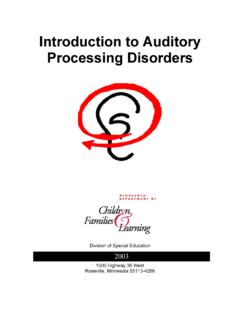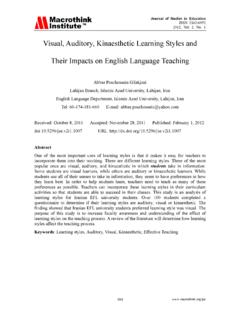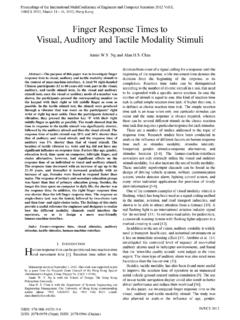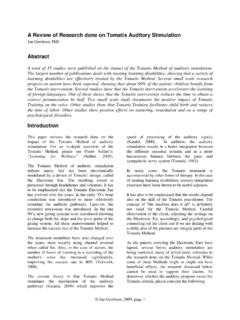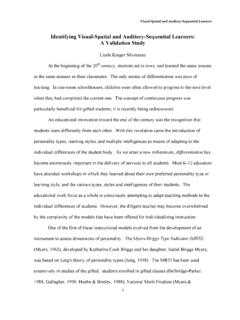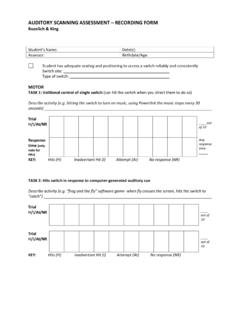Transcription of Auditory Scanning - Augmentative Communication Inc
1 1 July - August 1998 September - October 1998 Volume 11 Numbers 4 and 5 Clinical NewsAuditory Scanning (AS)On the WebAS Website and AS listservEquipmentAS devices and featuresFor ConsumersA survey of 28 AS usersCase ExamplesA closer lookThe AAC-RERCAAC-RERC goes virtual GovernmentalMedicare and AAC devicesContinued on page 2 Continued on page 2 Auditory ScanningAuditory Scanning (AS) is an AACaccess technique. In AS a communi-cation partner or a device with asynthetic voice announces vocabu-lary items, one at a time, until theAAC user hears what he or shewants to say and selects the item. Isthis approach to Communication slowand tedious? Most definitely. How-ever, AAC users who cannot use avisual-based system have clearlydemonstrated the value of Scanning can be doneusing no technology, light technology(non-electronic equipment) or highThis double issue of AugmentativeCommunication News focuses onAuditory Scanning (AS), a commu-nication technique designed toaddress the needs of individuals withsevere speech, motor and visualimpairments.
2 Although the numberof augmented communicators whouse Auditory Scanning techniques isrelatively small, the need for re-search, clinical strategies andinformation about the use of AStechniques is Clinical News section givesan overview of AS techniques andstrategies and identifies issues thatwarrant careful consideration whenplanning and implementing considers features ofhigh-tech AAC devices that offerAS options. Tables I and II listavailable AAC devices with auditoryscanning options. For Consumerssummarizes the results of a surveyconducted during 1998 amongprofessionals who work withindividuals who use AS shared informationabout the diagnoses, skills and usesof no-tech, light-tech and high-techstrategies and devices among 28auditory issue also introduces threenew sections of ACN. On the Webfeatures two new informationresources about Auditory AS Website has informationabout Auditory Scanning with links toother sites that focus on augmenta-tive Communication .
3 TheAS listserv seeks tofacilitate discussionsabout clinical andresearch issues. Thesevaluable resources were developedby David McNaughton in collabora-tion with Tracy Kovach and Case Examples sectionhighlights two Auditory scanners whowere included in the survey. Thissection allows for a more in-depthview of how some individuals areusing AS techniques. AAC-RERC introduces ACN s ongoing coverageof the new Rehabilitation Engineer-ing Research Center on to AugmentativeCommunication News will be kepttechnology (electronicequipment).No-techA partner presentslanguage in a linear scan. Which shirt do you want towear? The red one? The blueone? The striped one? Theaugmented communicator waits andindicates his choice by vocalizing,blinking, smiling or moving somebody part. This technique is knownas partner-assisted Auditory form of partner-assistedauditory Scanning , which is onlyslightly different, is asking yes/no questions.
4 For example, the partnersays, Do you want to wear thered one? and waits for a response2 Clinical News, Continued from page 1 Upfront, Continued from page 1abreast of the research andoutcomes of the Center over thenext five the Governmental section,we share with our readers astrategic approach that is designedto challenge (and change) Medi-care funding policy in the , individuals eligible forMedicare are most often excludedfrom reimbursement for AACdevices. This section provides anAAC assessment protocol forspeech-language pathologists thatwill increase the likelihood ofsuccessful reimbursement forMedicare funding of AAC protocol was developed bymaster clinicians and policymakers. Some may find it a usefulguideline for developing fundingrequests throughout the would like to thank all whocontributed to this issue.
5 The arelisted in Resources and Refer-ences section on page 15. I amparticularly grateful to TracyKovach who encouraged me towrite about this topic and inspiredthe heads up. We will bedeveloping an AugmentativeCommunication News/Alterna-tively Speaking Website over thenext six months. I welcome yoursuggestions with respect to bothform and , as we approach the 21stcentury, and electronic mail andresources permeate our lives evermore deeply, I would like to clarifyour protocol. All electronic ad-dresses listed in ACN will beunderlined and colored (blue). Sarah W. Blackstone, asking about the blue one or the striped one. No-tech strategies require noequipment, which is an addition, they can be very effi-cient with familiar partners. Adisadvantage is that augmentedcommunicators must rely on theirpartners to access language and,therefore, they remain in a positionof partner presents language tothe augmented communicator byreading from a card, communicationboard or a book in which the vo-cabulary is written down.
6 Aug-mented communicators select theirmessages, as described may hit a switch to indicatetheir choice (the switch is notconnected to a device or applianceat the time.)Vocabulary can be arranged in alinear fashion as described earlier, ormay be presented using branching,as described : The partner asks a question( , What would you like to do?)Then, the partner reads a list ofcategories from a card or book. Thecategories are organized in a way that ismeaningful to the AAC user. Forexample: Does it have something todo with .. Math? Free time? Reading? Gym?(Activity based)School? Home? Community?Babysitter s house? Supermarket?(Location based)Food? Clothing? Household items?(Taxonomic based)Mom? Dad? Teacher? Brother? (Peoplebased).Augmented communicator (AC): Theindividual selects a category, , Food. Partner: Additional items are pre-sented.
7 For example, the partner mightthen read .. Hamburger? Drink?Dessert? : The user selects what he wants, , Hamburger. Partner: The partner expresses theselection, , You want to eat ahamburger. The partner then asksabout toppings or a drink, and so systems have severaladvantages. They enable augmentedcommunicators to: (1) becomefamiliar with the language in theirsystem, (2) be less dependent upon aspecific partner s knowledge of theirneeds and preferences, (3) partici-pate in more activities, (4) developmore independence, and (5) estab-lish personal relationships with morepeople. In addition, light-techapproaches allow for more flexiblecommunication. Human partnersadapt more quickly to the shiftingneeds and circumstances of AACusers than machines. A majordisadvantage of light-tech systems,however, is that users are dependentupon partners to of a human partner, AACusers listen to a speech synthesizer(either digitized or synthesized) thatannounces the vocabulary items andspeaks the message that is users generally activate thescan by hitting a switch, and theauditory cues begin.
8 The user listensto the cues and selects the desired3 Continued on page 4message (or the category labelwhere the message is located) byhitting the switch again, and so communicators listen tothe Auditory cues either through anearphone, a speaker placed close tothe head, or the speaker in theirAAC device. Ideally, two differentvoices are used. One presents thecues; the second speaks the selectedmessage (the user s voice ). It isbetter if Auditory cues are notaudible to the communicationpartners because they can be verydistracting. However, during trainingsessions, the scan should be audibleto both Denver SymposiumSince 1995, four symposia onauditory Scanning have been hostedby The Children s Hospital inDenver, Colorado. Individualsinterested in AS have gathered eachyear to consider a wide range ofissues and to share concerns aboutauditory AS experience What is Auditory Scanning likefor the people who use it?
9 Ofcourse, we don t really knowbecause no AAC user has describedit. However, we do know that whenparticipants at the 1998 DenverSymposium were blindfolded andasked to play the role of an aug-mented communicator using a high-tech AS device, they provided someinsightful comments: I was overwhelmed. It was too noisyand hard to concentrate. I felt left out. I quit was my favoritemessage. I just wanted everyone to ask me yes/no questions. I became disengaged. After a whileeverything blended together and becamebackground noise. The volume was too low. Most of the time I couldn t answerthe questions people asked. I had trouble remembering wherethings were in the device. These comments suggest that theexperience of being visually impairedand an AS device user can be quitedisorienting and frustrating. Partici-pants also reported that auditoryscanning techniques requiredenormous concentration and a result of their experiences, theyrecommended several strategies:Consider using an in-the-ear speaker soit is easier for the user to listen to training sessions in augmented communicators inplanning and organizing they are involved, they don tknow what vocabulary is available, howit is organized or where to find Communication partners who arenatural speakers to use AS benefits?
10 Auditory Scanning techniquesoriginally were developed to accom-modate the needs of people withsevere Communication and motorimpairments who were unable to seevisual symbols. According toKovach and Kenyon,1 however, afew augmented communicators whoare not visually impaired may alsouse Auditory Scanning techniquesbecause Auditory feedback can helpthem:Learn the names or locations of their attention on the their vision to interact withpartners and scan the environment,rather than operate their AAC more accurate in their motorresponses. Some people have difficulty looking and hitting a switch because of abnormal and communicationVisually impaired infants missinterpersonal cues in Communication ,have difficulty developing person-person-object associations, and havea delayed knowledge of their body,limited mobility and fewer opportuni-ties for incidental Inaddition, linguistic input to individualswith visual impairment is likely to beless effective.
